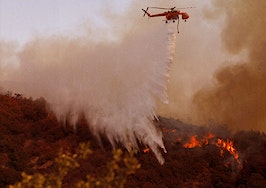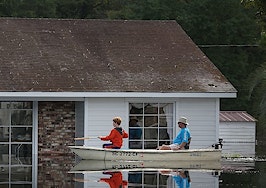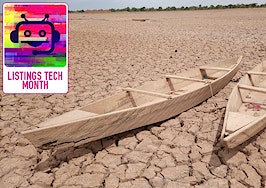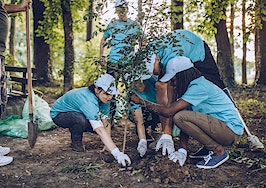Stacey Prior answered the phone Monday morning as she was comparing before and after photos.

Stacey Prior
“I had a home in escrow,” she told Inman on the call. “It burned to the ground.”
Prior works as an agent with Lake Almanor Brokers, which serves the area in and around Greenville, California. In recent days, Prior’s region has become the epicenter of the Dixie Fire, a massive inferno that has been burning for nearly a month and which so far has scorched nearly half a million acres.
To put that into perspective, that’s nearly the size of the combined land area of New York City and Los Angeles. Those figures also make the Dixie Fire the second largest fire ever recorded in California history.
“If I were to drive from one end of the fire to the other, we’re probably looking at 3 hours,” Prior, who was speaking from the Oregon coast because she was forced to evacuate, said of the area the blaze has covered.

Greenville, California, is burned beyond recognition on August 8, 2021. Credit: Maranie R. Staab and Getty Images.
Among other things, the Dixie Fire has destroyed most of Greenville’s historic downtown. In total, Cal Fire — California’s firefighting agency — said that as of Monday morning the blaze had burned more than 400 structures and threatened another 16,000. Crews had only managed to achieve 21 percent containment and don’t expect to have the fire fully under control until the end of the month.
On the phone with Inman, Prior ticked off a long list of buildings in her community that are now gone.
“Restaurants are gone, pharmacies are gone. Hotels, churches. The cosmetology shop. The Indian rancheria. The museum is gone with all of our historical Native American artifacts. The veterans hall. The town hall. The wellness center,” she said. “Just everything is gone. It’s just devastated.”

The remains of a burned church destroyed by the Dixie Fire in Greenville, California, as seen on Aug. 8. Credit: David Odisho and Getty Images
Prior also didn’t have information Monday about her own home’s status. She lives about five miles from Greenville on a small, unmarked street. But she had been repeatedly hearing that normally obscure street’s name in reports on the fire — raising the possibility that the flames swept through her area.
“We just can’t get any information,” Prior said. “We look at all the maps and some say our home is safe. Some say it’s right out my back door. And some show it completely engulfed.”
The Dixie Fire comes at the same time the United Nations released a sprawling new report that concludes climate change will intensify in the coming decades because humans have failed to cut fossil fuel emissions. The report, which was published Monday, paints a harrowing picture of a future that is hotter and more difficult to live in, thanks in part to wildfires that are getting worse.
Case in point: In California, six of the state’s ten largest fires ever have happened either this year or last year. As of Monday afternoon, there were also at least 18 other active wildfires burning in California, with dozens of others having already run their course earlier in the year.

A map of 2021 fires in California. Red represents active blazes while grey represents past fires. Credit: Cal Fire
It’s also worth noting that wildfire season now stretches well into the fall, and sometimes into winter as well. And that means there are still many more months during which flames are likely to sweep across the West.
Other parts of the West have already seen massive fires this season as well. In Oregon, for example, the Bootleg fire has burned 413,765 acres and was 96 percent contained as of Monday.
The result of these various fires in the West has been a suffocating plume of smoke that has gradually engulfed more and more of the U.S.
We know that a lot of you are probably sick of the smoke, and we are too! Conditions are likely to improve, but a noticeable haze will linger. Here is a look at the expected smoke trends over the next 30 hours. #utwx #wywx pic.twitter.com/vyZvPSOIMV
— NWS Salt Lake City (@NWSSaltLakeCity) August 9, 2021
Within the Dixie Fire’s burn area, authorities have said that there are at least five missing people, according to the Sacramento Bee.
This situation has disrupted numerous aspects of life in fire-prone areas, and the housing industry has often been on the front lines of that struggle.
Kristen King got a tragic and upfront view of that struggle over the last week.
King is one of Prior’s clients and told Inman Monday that she and her boyfriend closed on their first home together in January. She described the property as a “little cabin-style house in Greenville.”
King and her boyfriend were forced to evacuate in July and watched reports from afar as the fire bore down on their new residence. Then last week, they got the bad news.
“Thursday morning we found out,” King told Inman. “We had become friends with our neighbor and he was able to drive through and look at some of the damage. He told us our house was gone. Just leveled.”
King and her boyfriend — who were drawn to the area thanks in part of their love of the outdoors — spent the next several days camping and “trying to process everything.”
“We were in shock,” King said. “I think we’re just now coming out of the shock. Obviously you’re sad, but you kind of feel numb a little bit.”
King said she hopes to rebuild and stay in the area, but plans to spend the next week on the phone with insurers and others trying to figure out what her options are.

The Greenville Library is surrounded by rubble as the Dixie Fire continues to burn on Aug. 6. Credit: Trevor Bexon and Getty Images.
Others in the area are also still trying to figure out what they’re going to do. Among them, Cassie Barr — an agent with Feather River Properties in Greenville — said the devastation came for her on multiple fronts.

Cassie Barr
“Our office completely burned down,” she told Inman Monday morning. “I have a couple of rental properties that burned. I had a couple of homes closing this week and they burned down, too.”
Barr spoke with Inman while evacuated, and like Prior she didn’t have information about the status of her own home; the U.S. National Guard was keeping residents out of the area, though she had heard the fire was moving toward her property.
“We’re still in huge fire danger,” she added. “My house is on the back side of the valley and now the fire is threatening my house.”
Barr went on to say that once she’s allowed back into the area, she hopes to take her trailer, park it in a place that’s accessible for her clients, and help them figure out what to do next. That include involve valuing properties for people who want to sell, or helping them look for new places to live.

A burned car sits in front of a home that was destroyed by the Dixie Fire on July 26, 2021 in Indian Falls, California. Credit: Justin Sullivan and Getty Images
However, Barr’s job may prove to be deceptively challenging. Barr said that after the Camp Fire destroyed the town of Paradise in 2018, property values soared in Greenville, which is located about 90 miles away, as a flood of fire refugees looked for housing. That suggests housing prices in the area of this year’s Dixie Fire could soar thanks to reduced supply — something that could hurt Barr’s clients who are looking for homes.
On the other hand, Barr pointed out that “we have no community” left at this point, which means prices could also plummet.
Compounding these issues is the fact that insuring properties against fire damage is becoming more and more expensive in much of the West. And that, too, makes housing more expensive.
All of which is to say that with the Dixie Fire still raging out of control, it’s difficult to know what kind of supply or demand of housing will exist when the smoke clears. Either way, though, Barr anticipates doing whatever she can for her clients.
“There’s probably going to be a lot of pro bono stuff, helping out,” she said. “We’re all going to learn together.”
For the time being though, the only thing that’s for certain is trauma.
Like King, Prior said she loves the area and would like to stay. But she also said it could be a struggle waking up each morning to a charred landscape that serves as a constant reminder of what was lost. And in the meantime, even the slightest thing can become a trigger.
“PTSD is a real thing,” she said. “Every time the wind blows, we all just tense up.”








